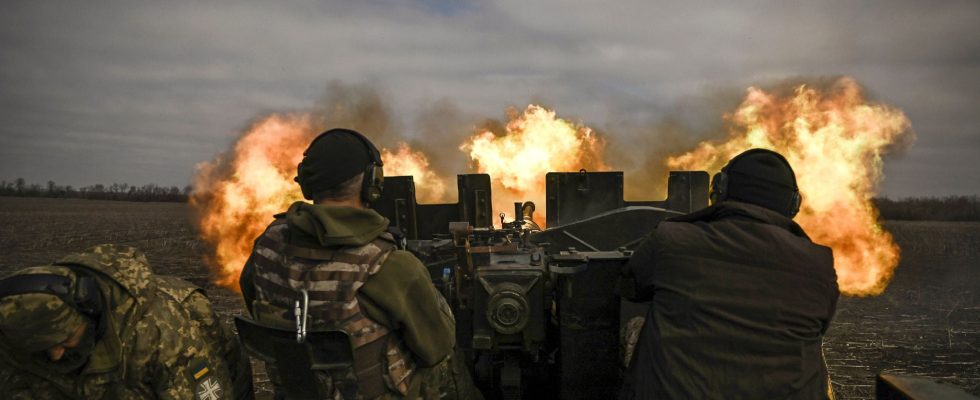Arm yourself to better protect yourself, or arm yourself to better attack? In light of an increase in international conflicts in Eastern Europe and the Middle East, and a persistent threat in the China Sea, States are relaunching their war machine.
According to a report published by the Stockholm International Peace Research Institute (SIPRI) published this Monday, April 22, global military spending increased by 6.8% in 2023. An unprecedented increase since 2009, which brings their level to 2,443 billions of dollars.
The United States, China and Russia on the podium
Unsurprisingly, the United States, China and Russia are on the podium of the most expensive countries in terms of arms. In 2023, Washington spent $916 billion, including $35.7 billion to support Kiev. At war with Moscow since February 2022, Ukraine has doubled its military budget in 2023. Defensive spending thus represents 58% of total public spending, notes Sipri. After long and laborious negotiations, the American House of Representatives adopted on Saturday an aid plan for Ukraine supported by elected officials from both sides. Nearly $61 billion, the majority of approved funds, is dedicated to the war in Ukraine.
To the Russian-Ukrainian conflict was added the war in the Middle East triggered by the Hamas attack on October 7. Thus, the American Congress also validated in November military aid of 14.5 billion intended to support Israel in its war against Hamas. The Jewish state itself increased its military spending by a quarter in 2023, reaching $27.5 billion at the end of the year.
More generally, the military budget in the Middle East increased by 9%, the highest annual growth rate recorded in the region. “The sharp increase in military spending in the Middle East in 2023 reflects the rapidly changing situation in the region, from the warming of diplomatic relations between Israel and several Arab countries in recent years to the outbreak of a major war in Gaza and fears of region-wide conflict,” said Diego Lopes da Silva, senior researcher for SIPRI’s program on military spending and arms production. Iran, which launched an unprecedented offensive against Israel on April 13, also increased its military budget, increasing from 27% to 37% between 2019 and 2023, according to data cited by Sipri.
Is China preparing its offensive on Taiwan?
For its part, the Middle Kingdom has injected $296 billion into its arms industry, an increase of 6% compared to 2022 and 60% in ten years. An increase attributed to the hawkish ambitions of the Chinese giant over its Taiwanese neighbor, whose defensive budget has notably increased by 11% in 2023. “China devotes a large part of its growing military budget to improving the state of preparedness for combat of the People’s Liberation Army,” said Xiao Liang, a researcher with SIPRI’s Military Expenditure and Weapons Production program.
The acceleration of Beijing’s rearmament has hastened its neighbors to increase their defensive capabilities. Japan, first, which allocated more than $50 billion to its army in 2023, or 11% more than in 2022. India, also, which increased its spending by 4.2% in 2023 and which ranks fourth among the highest spending countries on military matters with nearly 84 billion dollars allocated to the arms industry last year.
Europe is also rearming
While a conflict of unprecedented scale since the Second World War thunders at the gates of Europe, fourteen countries of the European Union took up their pens in a joint letter in mid-March. Their purpose? Obtain from the European Investment Bank an increase in its financing in the European arms and defense industries.
However, most did not wait for Brussels to boost their national military arsenal. Sharing a common border 535 kilometers long with Ukraine, and located some 1,000 kilometers from Russia as the crow flies, Poland has notably increased its budget dedicated to Defense by three quarters in 2023.
Further west, Berlin broke with a 70-year tradition of military abstention by delivering arms to Ukraine and revitalizing its defense industry. The German defense budget has thus almost doubled in ten years, and increased by 9% in 2023. With this 180-degree turn which brings military spending to nearly 65 billion dollars, our neighbors across the Rhine are ahead by a few billion dollars the French budget allocated to defense which just exceeds 61 billion dollars.
“The unprecedented increase in military spending is a direct response to the deterioration of peace and security in the world,” explains Nan Tian, principal researcher of the SIPRI program on military spending and arms production. And to warn: by prioritizing their military power “in an increasingly unstable geopolitical and security landscape”, States risk “entering into a spiral of action-reaction in a geopolitical and security landscape” .
